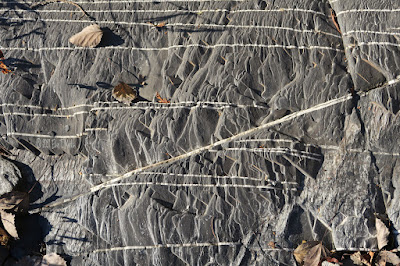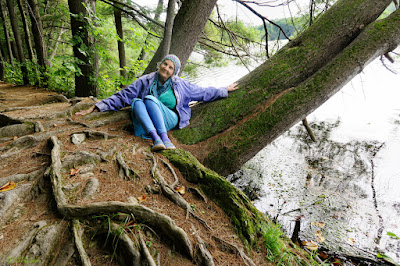Sunday, December 24, 2023
Thursday, December 21, 2023
Happy Winter Solstice!
Wishing I was in this spot right now.
Wednesday, December 13, 2023
Fragrance Free Respect
Tuesday, December 12, 2023
Iberville Shale
Iberville shale
The flat, dark gray stones streaked with unmistakable white lines on the shores of Lake Champlain are Iberville shale – a name that comes from the Quebec town where the shale was discovered by Western geologists. It’s a thinly layered, sedimentary rock that was formed from marine silt deposited roughly 500 to 440 million years ago. Iberville Shale was created during the Ordovician period, when almost all of the earth north of the tropics was ocean. The silt deposited deep in these ocean waters became shale as it hardened and compacted over time. It’s younger than most other sedimentary rocks in the Champlain Valley, which date back 600-500 million years. The tell-tale white stripes are veins of mineral calcite formed by powerful compressing forces that drove calcium carbonate in the water to coalesce into mineral calcite.
Wednesday, November 29, 2023
Indian Pipe Plant
Indian Pipe Plant, Ghost pipe, Ghost Plant, Corpse Plant, Dutchman's Pipe, Monotropa Uniflora
This unusual plant has no chlorophyll, so is not green. It therefore cannot make its own food, and is a parasite having a relationship with a fungus and a tree. It takes nutrients from both and so is found under American beech and pines along with types of mushrooms which include the Russula and Lactarius mushrooms.
Disclaimer
My blog is meant to inform and I strive to be totally accurate. It is solely up to the reader to ensure proper plant identification. Some wild plants are poisonous or can have serious adverse health effects.
Thursday, November 23, 2023
Giving Thanks
Sunday, November 19, 2023
Canada Anemone
Disclaimer
My blog is meant to inform and I strive to be totally accurate. It is solely up to the reader to ensure proper plant identification. Some wild plants are poisonous or can have serious adverse health effects.
Saturday, November 18, 2023
Nuthatch Parenting
Monday, October 9, 2023
The Old Round Church In Richmond, Vermont
The Old Round Church In Richmond, Vermont With Fall Afternoon Shadows
Sunday, October 8, 2023
On The Rocks Or Ode To An Inchworm
Thursday, September 14, 2023
Loving The Forest in Vermont
Wednesday, September 13, 2023
Tuesday, September 5, 2023
Sunflowers Galore
Sunflowers With A View At The Adams Berry Farm in Charlotte.
Sunny Closeup
Me In The Fields of Sunflowers In the IslandsFields of Sunflowers In the IslandsSunflower Of A Different Color
Sunflower Maxamillion With Bee
Sunflower With BeeSunflower in the Barnyard
Field Of Happiness
Sunflowers With A View in Fairfax
SunFlowers Border
Sunflowers grown as a living fence around a field.
You can see more of my creations at:
My photographs are available for purchaseThanks for your visits, favs and comments. As always, appreciated very much!© all rights reserved by Elise T. Marks. Please do not use this image on websites, blogs or any other media without my explicit written permission.
Thursday, August 31, 2023
Wildcrafting
Wildcrafting isn’t as simple as going out and digging an identified plant out of the ground in order to use it! Learning and teaching others how to harvest plants must be combined with a fair amount of instruction on why one should harvest in the first place, which plants to harvest, when to harvest, and how to do it in a sustainable way. Ethics and sustainability should always be in the forefront of our minds as we forage! 🍃
While there is a lot of information we herbalists should pass on to wildcrafting newbies, perhaps the most important is teaching about at-risk plants and why we should not harvest them. 🍃
At-risk plants are either naturally rare in the environment or becoming rare through human influence. Just as some plants reproduce and spread quickly and are often termed as “invasive” plants, there are those that are quite the opposite. These are naturally rare – due to slow growth habits, habitat incompatibility, population isolation, genetic incompatibility, problems with seed dispersal, loss of pollinators (can be caused by human influence), or by competition from or overpopulation of invasive plants and animals ... and so forth! 🌼
As herbalists, our work revolves around plants, so it is important we use plants in a wise manner—protecting and preserving them with their long-term viability in mind, not just for our sakes, but for the sake of the plant and the ecosystem. We must ask ourselves if we truly need the plant we’re considering using and we must help others understand this importance, too.
Becoming a responsible wildcrafter sometimes means not harvesting a plant if the population simply cannot support that impact and sustain itself, or whenever you are not sure what the impact of harvesting could be. This is why it’s so important to study foraging with a mentor or reputable school and to make sure you’re aware of sustainable guidelines before you start harvesting.
Species At-Risk List via United Plant Savers –– Sandalwood, Kava Kava, American Ginseng, Venus Fly Trap, Sundew, Maidenhair Fern, Cascara Sagrada, Squirrel Corn, Goldenseal, Lady’s Slipper, Orchid, Ramps, Lomatium, False Unicorn Root, Peyote, Stream Orchid, White Sage, Osha, Bloodroot, Virginia Dutchman's Pipe Trillium, Beth Root, True Unicorn Root, Blue Cohosh, Echinacea, Elephant Tree, Wild Indigo, Butterfly Weed, Stone Root, Wild Yam, Yerba Mansa, Black Cohosh, Eyebright, Pipsissewa, Chaparro, Pink Root, Mayapple, Slippery Elm, Lobelia, Arnica, Gentian, Goldthread























































